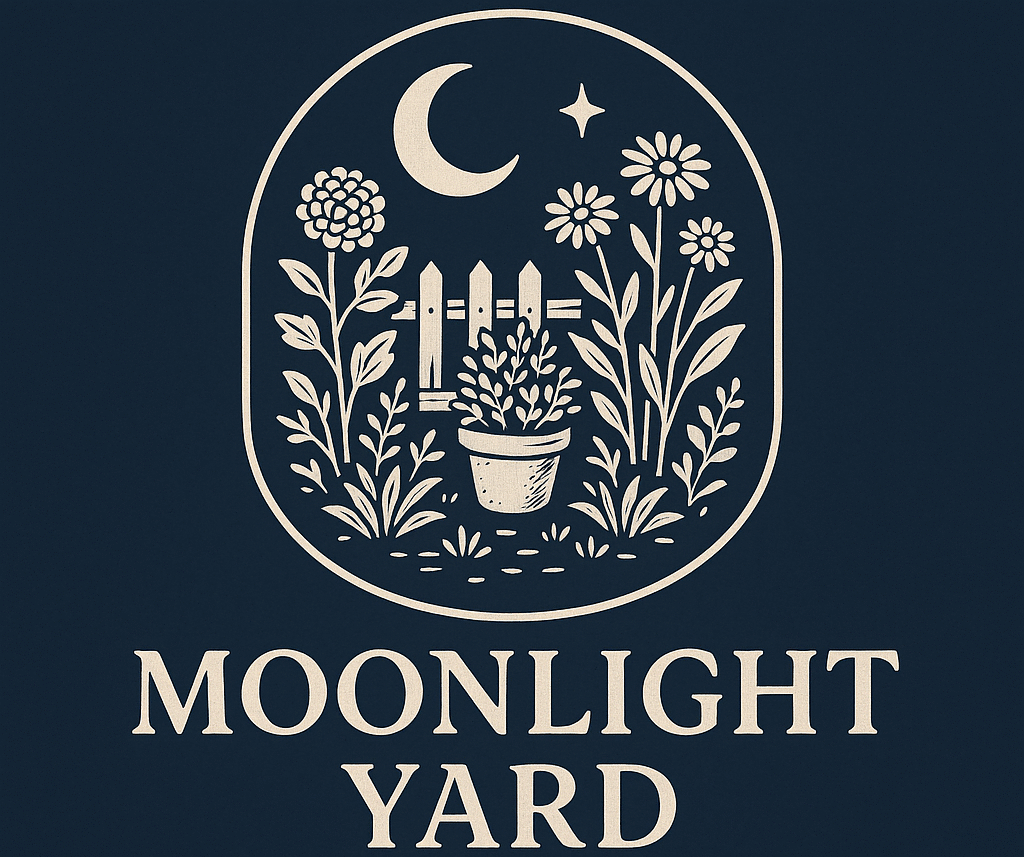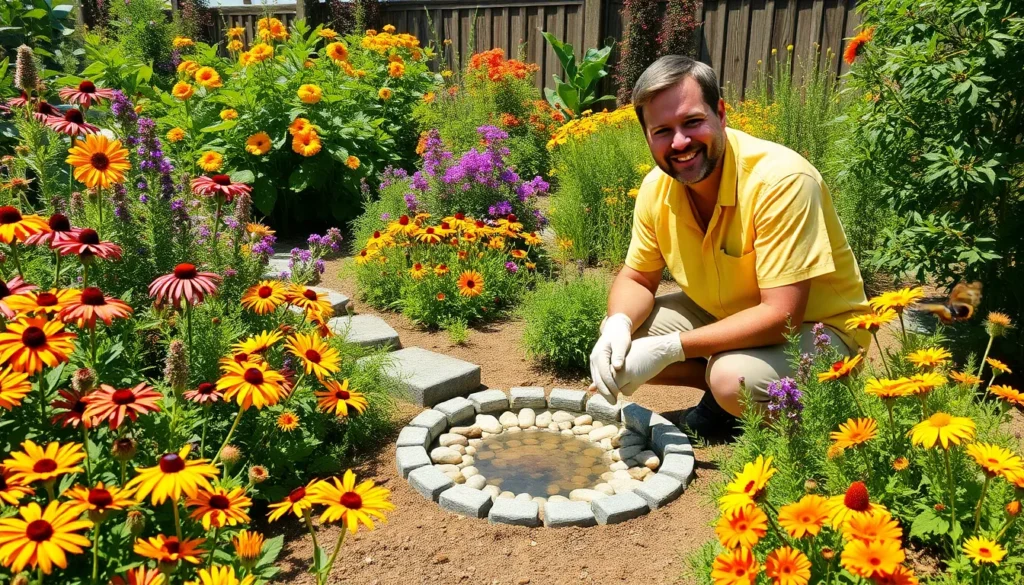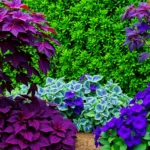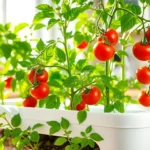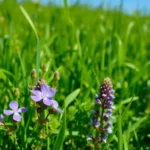We’ve all watched in wonder as colorful butterflies dance through our gardens, bringing life and magic to outdoor spaces. Creating a butterfly garden isn’t just about planting pretty flowers – it’s about designing a sanctuary that supports these delicate pollinators throughout their entire lifecycle.
Transform your backyard into a butterfly paradise with strategic plant choices and thoughtful design elements. From nectar-rich blooms that fuel adult butterflies to host plants where they’ll lay their eggs, every decision you make can attract more of these stunning creatures to your space.
Whether you’re working with a sprawling yard or a compact balcony, we’ll show you how to create an irresistible haven for butterflies. The best part? These gardens require minimal maintenance once established, giving you maximum beauty with minimal effort while supporting local ecosystems and creating a peaceful retreat you’ll love spending time in.
Create a Welcoming Habitat With Native Flowering Plants
Native flowering plants form the foundation of successful butterfly gardens because they’ve evolved alongside local butterfly species for thousands of years. We’ll explore the most effective native options that provide both nectar sources and essential habitat features.
Choose Region-Exact Wildflowers
Regional wildflowers offer butterflies the familiar nectar sources they’ve adapted to use over generations. Different geographic areas support distinct butterfly populations, so matching your plant selections to your exact region creates the strongest attraction for local species.
Eastern gardeners should prioritize New England asters, wild bergamot, and goldenrod which bloom at different times throughout the growing season. These wildflowers support over 40 butterfly species including painted ladies, skippers, and sulfurs while requiring minimal water once established.
Midwest regions benefit from prairie blazingstar, wild lupine, and native sunflowers that thrive in variable weather conditions. Prairie blazingstar attracts fritillaries and crescents, while wild lupine serves as the exclusive host plant for endangered Karner blue butterflies.
Western gardeners can plant California poppies, desert marigold, and penstemon species that tolerate drought conditions naturally. Desert marigold blooms nearly year round in suitable climates, providing consistent nectar when other flowers fade.
Southern regions support butterfly weed, coral honeysuckle, and native salvias that handle heat and humidity effectively. Coral honeysuckle attracts both butterflies and hummingbirds while climbing structures or fences to maximize vertical growing space.
Plant Milkweed for Monarch Butterflies
Milkweed species serve as the exclusive host plants for monarch butterflies, making them essential for any butterfly garden focused on supporting these iconic migrants. Female monarchs will only lay eggs on milkweed plants because the toxic compounds in milkweed leaves protect monarch caterpillars from predators.
Common milkweed grows 3 to 4 feet tall and produces large clusters of pink flowers that attract many butterfly species beyond monarchs. This variety spreads through underground rhizomes, so we recommend planting it in areas where natural spreading won’t interfere with other garden elements.
Swamp milkweed thrives in moist soil conditions and produces smaller pink or white flower clusters from June through August. Gardeners with wet areas or rain gardens find this species particularly valuable because it doesn’t spread as aggressively as common milkweed.
Butterfly weed displays bright orange flowers and tolerates drought conditions better than other milkweed varieties. This species stays compact at 1 to 2 feet tall and won’t spread through rhizomes, making it perfect for formal garden borders or container plantings.
Tropical milkweed works well in southern regions but requires careful management in areas where monarchs overwinter. We recommend cutting tropical milkweed back to 6 inches in late fall to prevent disrupting monarch migration patterns.
Include Purple Coneflowers and Black-Eyed Susans
Purple coneflowers and black-eyed Susans create the backbone of native butterfly gardens because they bloom for extended periods and attract dozens of butterfly species. These prairie natives require minimal maintenance once established and provide seeds for birds during fall and winter months.
Purple coneflowers bloom from July through September with large daisy-like flowers featuring prominent central cones. Butterflies including great spangled fritillaries, painted ladies, and red admirals frequently visit these flowers for their abundant nectar reserves.
Different purple coneflower varieties offer varying heights and bloom times to extend the flowering season. ‘Magnus’ grows 3 feet tall with large purple petals, while ‘White Swan’ provides white blooms that show up beautifully in evening gardens.
Black-eyed Susans produce bright yellow flowers with dark centers from June through October in most regions. These cheerful blooms attract hairstreaks, skippers, and sulfur butterflies while self-seeding to create natural drifts over time.
Rudbeckia species include both annual and perennial varieties that adapt to different garden conditions. Sweet black-eyed Susan works well in partially shaded areas, while prairie black-eyed Susan handles full sun and dry conditions effectively.
Both plant types form attractive clumps that we can divide every 3 to 4 years to create new plants for expanding butterfly gardens. Fall division works best because it allows plants to establish root systems before the following growing season.
Design Your Garden Layout for Maximum Butterfly Appeal
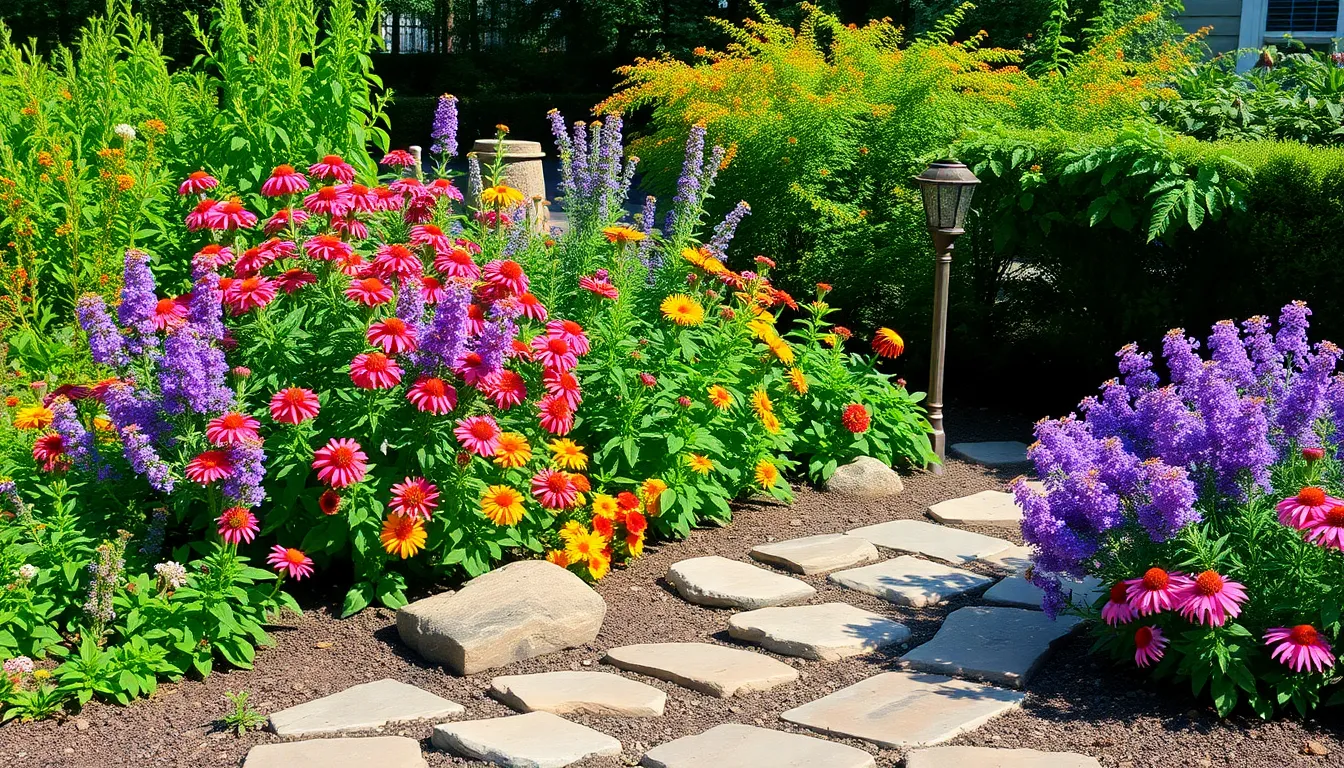
Creating an effective butterfly garden requires strategic planning that goes beyond simply selecting beautiful plants. We’ll guide you through essential layout principles that maximize butterfly activity and ensure your garden becomes a thriving pollinator haven.
Create Sunny Open Spaces
Butterflies need substantial sunlight to maintain their energy levels and actively visit flowers throughout the day. We recommend designing your garden in an area that receives 6–8 hours of direct sunlight daily, as this duration provides optimal conditions for butterfly activity and flower visitation.
An ideal butterfly garden spans approximately 100 square feet (such as a 10×10 foot area), which allows sufficient space for plant diversity while remaining manageable for maintenance. This size accommodates multiple plant clusters and creates distinct zones for different butterfly species.
Position your garden away from tall buildings, dense tree canopies, or other structures that cast prolonged shadows. Open spaces allow butterflies to navigate easily between plants and provide clear flight paths for courtship displays and territorial behaviors.
Add Sheltered Areas for Rest and Protection
Butterflies require protected spaces where they can rest, seek shelter from strong winds, and hide from predators during vulnerable periods. We suggest incorporating shrubs, ornamental grasses, or small trees around the perimeter of your sunny garden space.
These sheltered areas serve multiple purposes: they provide windbreaks that protect delicate butterfly wings, offer roosting spots for overnight rest, and create microclimates that extend the garden’s usable season. Plant these protective elements on the north or west sides of your garden to shield against harsh weather while maintaining southern exposure.
Include flat stones or rocks in sunny spots near sheltered areas, as butterflies use these surfaces for basking and absorbing warmth to regulate their body temperature. Position these basking stones where they’ll receive morning sun but have nearby shelter options.
Plan for Continuous Blooming Seasons
Successful butterfly gardens provide nectar sources from spring through fall, ensuring consistent food availability throughout the butterfly lifecycle. We recommend selecting plants with staggered blooming periods to create seamless transitions between flowering seasons.
| Season | Key Plants | Bloom Duration |
|---|---|---|
| Spring | Columbine, Early Salvias | April-May |
| Summer | Buddleia, Lantana, Coreopsis | June-August |
| Fall | Hardy Hibiscus, Liatris | September-October |
Arrange plants in clusters of the same species rather than single specimens, as butterflies can more easily locate concentrated nectar sources. Group 3-5 plants of each variety together to create visual impact and efficient feeding stations.
Consider bloom succession when planning plant placement, ensuring that as one species finishes flowering, another begins nearby. This strategy keeps butterflies in your garden longer and supports multiple generations throughout the growing season.
Select the Perfect Nectar-Rich Flowers by Color
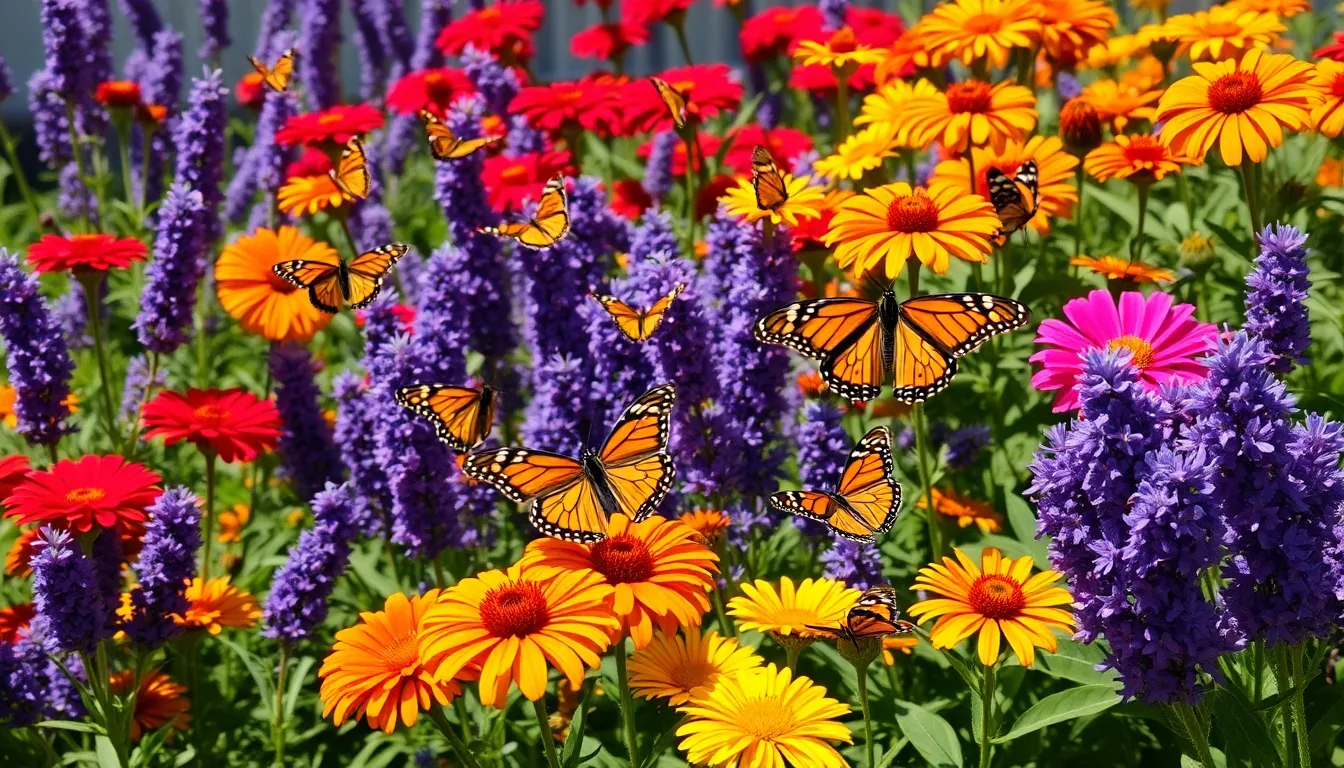
Color coordination in butterfly gardens creates stunning visual displays while maximizing nectar availability for different species. Strategic flower selection by color ensures our gardens attract diverse butterfly populations throughout the growing season.
Plant Red and Orange Blooms Like Zinnias
Zinnias stand out as top performers for their vibrant colors and abundant nectar production. These hardy annuals attract painted lady and American lady butterflies with their rich, accessible nectar sources. We recommend planting multiple zinnia varieties to extend blooming periods from early summer through fall.
Mariposa lilies add elegant beauty to red and orange garden sections with their distinctive cup-shaped blooms. These native wildflowers provide essential nectar while requiring minimal maintenance once established. Plant them in well-draining soil where they’ll naturalize and return each year.
Lantana creates continuous color with its clustered flowers that bloom repeatedly throughout warm months. This heat-tolerant perennial produces nectar that attracts various butterfly species including Gulf fritillaries and skippers. Choose native lantana varieties for best results in supporting local butterfly populations.
Include Purple Favorites Such as Lavender and Salvia
Lavender offers dual benefits with its soothing fragrance and high nectar content that appeals to many butterfly species. This drought-tolerant perennial blooms for extended periods and provides essential oils that naturally repel garden pests. We suggest planting English lavender in sunny locations with excellent drainage.
Salvia attracts butterflies consistently with its rich purple flower spikes that contain easily accessible nectar. These versatile perennials bloom repeatedly when deadheaded regularly and thrive in various soil conditions. Choose native salvia species like autumn sage for best adaptation to local growing conditions.
Purple coneflowers extend the color palette while providing reliable nectar sources for butterflies like painted ladies and red admirals. These native wildflowers bloom from midsummer through early fall and require minimal care once established. Their sturdy stems and long-lasting blooms make them excellent anchor plants for purple garden sections.
Add Yellow Attractions Like Marigolds and Sunflowers
Marigolds provide bright, cheerful blooms that produce abundant nectar throughout the growing season. These easy-care annuals attract small butterfly species including sulfurs and skippers with their accessible flower structure. We recommend French marigolds for their compact growth habit and continuous blooming.
Sunflowers create dramatic focal points while offering rich nectar sources for larger butterfly species. These towering annuals produce multiple flower heads that extend the nectar availability period. Plant dwarf sunflower varieties in smaller spaces or use giant varieties as natural butterfly perches and windbreaks.
Black-eyed Susans complete yellow sections with their daisy-like blooms that attract many butterfly species including monarchs and fritillaries. These native wildflowers bloom from midsummer through fall and self-seed readily for natural garden expansion. Their sturdy growth habit and long blooming period make them essential additions to any butterfly garden color scheme.
Incorporate Essential Host Plants for Butterfly Reproduction
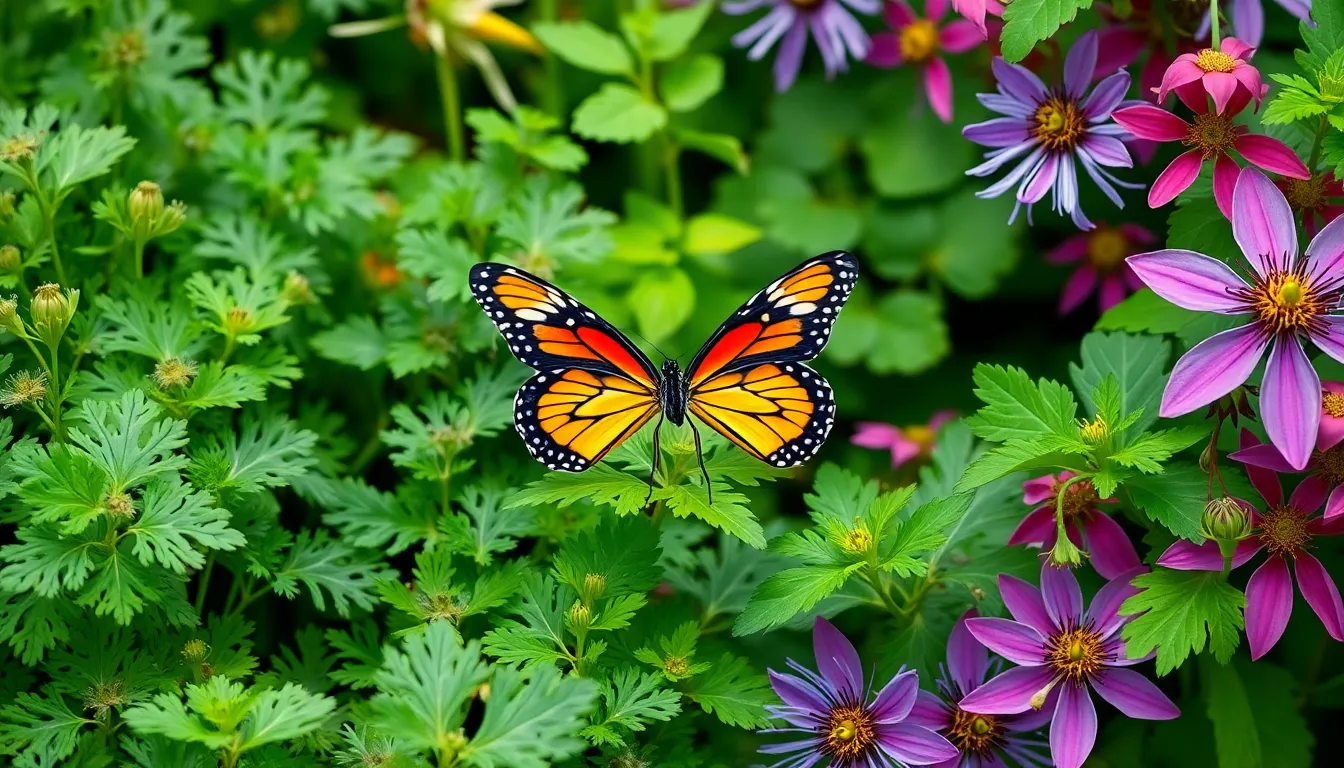
Creating a thriving butterfly habitat requires more than just nectar sources. We must include exact host plants where butterflies can lay their eggs and caterpillars can feed during their crucial development stages.
Provide Parsley and Dill for Swallowtail Caterpillars
Parsley and dill serve as essential host plants for swallowtail caterpillars throughout their larval development. These common herbs offer dual benefits by supporting butterfly reproduction while providing fresh ingredients for our kitchen gardens. Swallowtail butterflies specifically seek out these aromatic plants to deposit their eggs, ensuring their offspring have immediate access to suitable food sources.
We can easily incorporate these herbs into existing garden beds or container plantings. Parsley thrives in partial shade conditions and produces abundant foliage that caterpillars consume during their growth phases. Dill grows quickly from seed and self-sows readily, creating sustainable habitat for multiple generations of swallowtail butterflies. Both plants tolerate various soil conditions and require minimal maintenance once established in appropriate locations.
Plant Passion Vines for Gulf Fritillary Larvae
Passion vines prove essential for Gulf fritillary larvae development and successful butterfly reproduction cycles. These vigorous climbing plants produce distinctive flowers while serving as exclusive host plants for Gulf fritillary caterpillars. We should position passion vines along fences, trellises, or pergolas where they can spread naturally and provide ample feeding areas.
Gulf fritillary butterflies depend entirely on passion vine species for their reproductive success. These orange and black butterflies lay their eggs exclusively on passion vine leaves, where caterpillars feed and develop into chrysalises. The vines produce tropical-looking blooms that attract adult butterflies for nectar while simultaneously supporting their offspring through complete metamorphosis stages.
Include Spicebush for Spicebush Swallowtail Butterflies
Spicebush provides critical habitat for spicebush swallowtail butterflies throughout their reproductive cycle. This native shrub grows well in partially shaded areas where many other butterfly plants struggle to thrive. We can establish spicebush in woodland gardens, naturalized areas, or as understory plantings beneath larger trees.
Spicebush swallowtail caterpillars create distinctive shelters by folding spicebush leaves around themselves for protection. These green caterpillars with prominent eyespots feed exclusively on spicebush foliage during their larval stage. The shrub produces small yellow flowers in early spring and bright red berries in fall, adding seasonal interest while supporting specialized butterfly populations that depend on this native plant species.
Add Water Features to Support Butterfly Needs
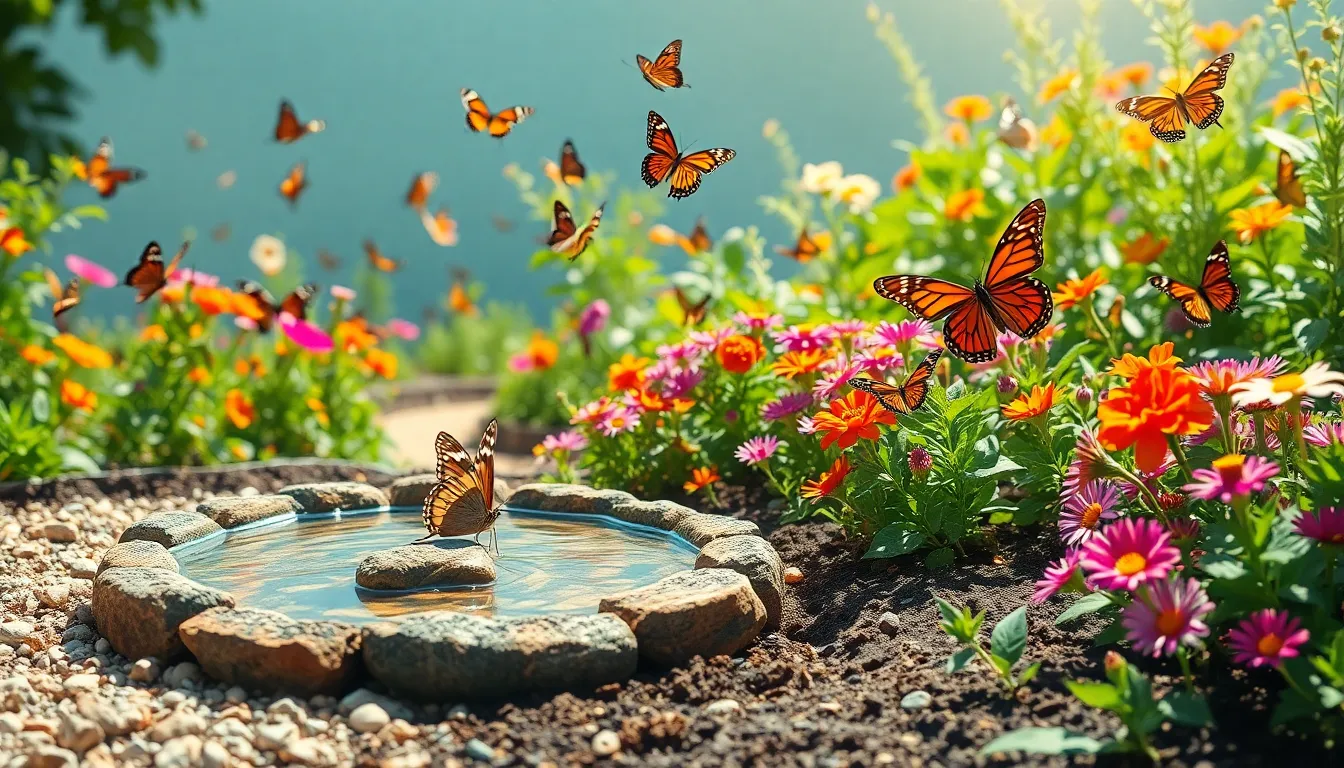
Water sources are essential components that make our butterfly gardens complete habitats. Butterflies need water not just for drinking but also for extracting vital minerals that support their health and reproduction.
Install Shallow Puddling Stations
Shallow puddling stations provide butterflies with mineral-rich water sources they can’t find in regular birdbaths. We recommend creating these stations using small containers filled with sand or pebbles and adding water until it barely covers the surface. Position these stations throughout the garden to give butterflies easy access to minerals like sodium and amino acids.
Sand works particularly well as a base material because it holds moisture and allows butterflies to extract nutrients effectively. Place small pebbles around the edges to create landing spots where butterflies can perch safely while drinking. Change the water every few days to prevent mosquito breeding and maintain fresh mineral sources.
Create a Small Butterfly Bath
Small butterfly baths offer versatile water access that accommodates different butterfly species and their varying needs. We suggest using clay saucers or shallow birdbaths filled with no more than half an inch of water. Add small rocks or twigs to create perching surfaces that extend above the waterline.
Position these baths in sunny areas where butterflies naturally gather to bask and feed. Select containers with rough surfaces that provide grip for butterfly feet, as smooth surfaces can be challenging for them to navigate. Clean the baths weekly to remove algae and debris that might deter butterflies from using them.
Maintain Moist Soil Areas for Minerals
Moist soil areas serve as natural mineral deposits that butterflies seek out for essential nutrients. We create these areas by watering exact garden sections regularly or installing drip irrigation systems that keep soil consistently damp. Focus on areas near flowering plants where butterflies already congregate for nectar.
Choose spots with clay-rich soil when possible, as these retain moisture longer and contain higher mineral concentrations. Add a thin layer of compost to boost nutrient content and create an even more attractive environment for butterflies. Monitor these areas during hot weather to ensure they don’t dry out completely, as consistent moisture is crucial for mineral extraction.
Use Natural Pest Control Methods
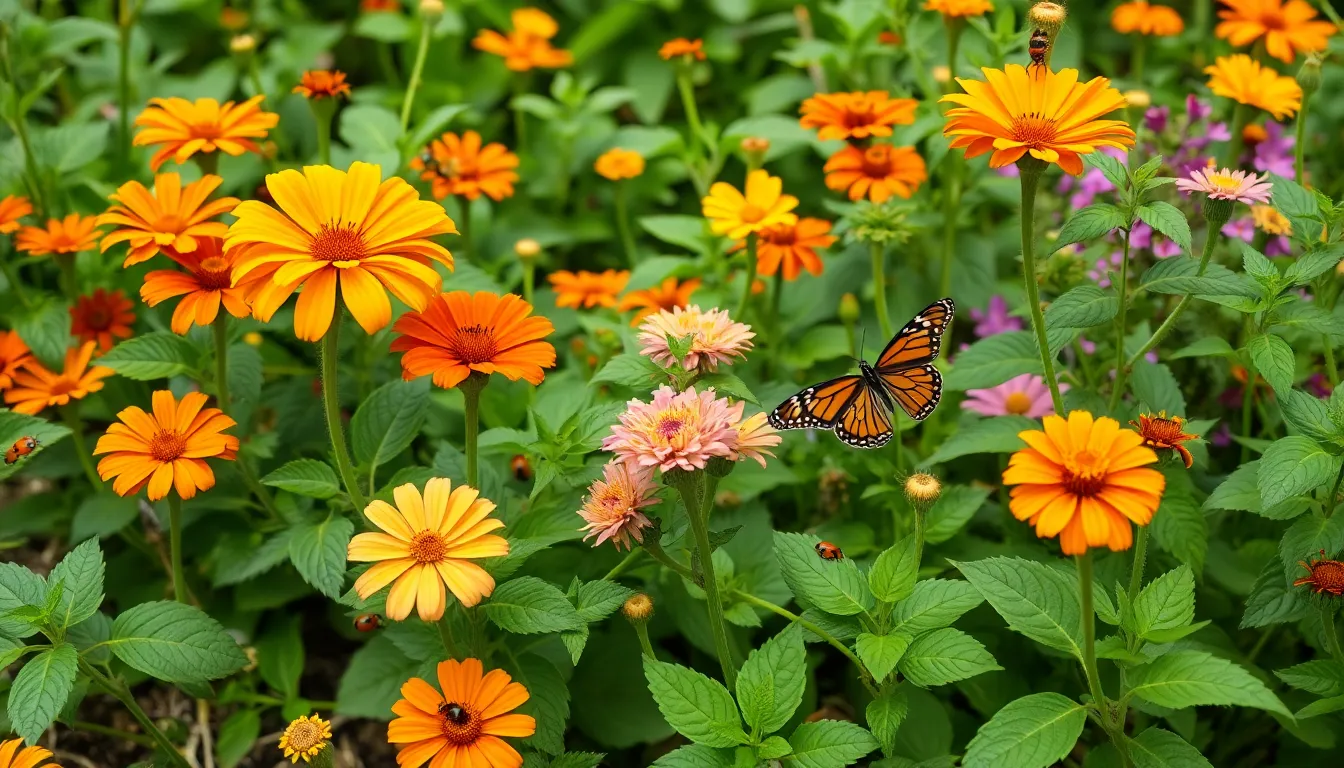
Protecting our butterfly garden from harmful pests requires strategic approaches that safeguard the delicate insects we’re working to attract. We’ll carry out natural methods that maintain the ecological balance essential for butterfly survival.
Avoid Chemical Pesticides and Herbicides
Chemical pesticides pose serious threats to butterflies and other beneficial insects in our gardens. We recommend switching to neem oil or pyrethrin as safer alternatives for managing pest problems without harming butterfly populations. These natural answers target exact pests while preserving the delicate network we’ve carefully cultivated.
Traditional herbicides eliminate the very wildflowers and native plants butterflies depend on for survival. Instead, we use natural mulch made from grass clippings or shredded leaves to control weeds effectively. This organic approach reduces our need for chemical weed killers while enriching soil nutrients naturally.
Encourage Beneficial Insects
Beneficial insects create a balanced network that naturally controls harmful pests in our butterfly gardens. We attract ladybugs and lacewings by planting flowers rich in nectar and pollen, establishing natural predator populations that keep pest numbers manageable. These helpful insects prey on aphids, spider mites, and other common garden pests without chemicals.
Bees work alongside butterflies as essential pollinators, so we design our gardens to support both species simultaneously. We include diverse flowering plants that bloom at different times, ensuring consistent food sources for all beneficial insects throughout the growing season.
Bacillus Thuringiensis (B.T.) serves as a targeted biological control for exact caterpillars that damage plants. We apply this natural bacteria carefully to avoid affecting beneficial butterfly larvae, using it only when necessary for severe infestations.
Practice Companion Planting Techniques
Companion planting naturally deters pests while supporting butterfly friendly plants in our gardens. We plant basil alongside butterfly attracting flowers because it repels aphids and other harmful insects without chemicals. This strategic pairing protects our nectar sources while providing fresh herbs for our kitchen.
Sacrificial plants like collards draw pests away from our main butterfly garden crops. We position these trap plants at garden edges, allowing us to manage pest populations more easily while protecting our primary butterfly habitat.
Marigolds serve dual purposes as both pest deterrents and butterfly attractants in our companion planting schemes. We scatter these bright flowers throughout our gardens, where they repel harmful nematodes while providing nectar for various butterfly species.
Design Seasonal Interest for Year-Round Appeal
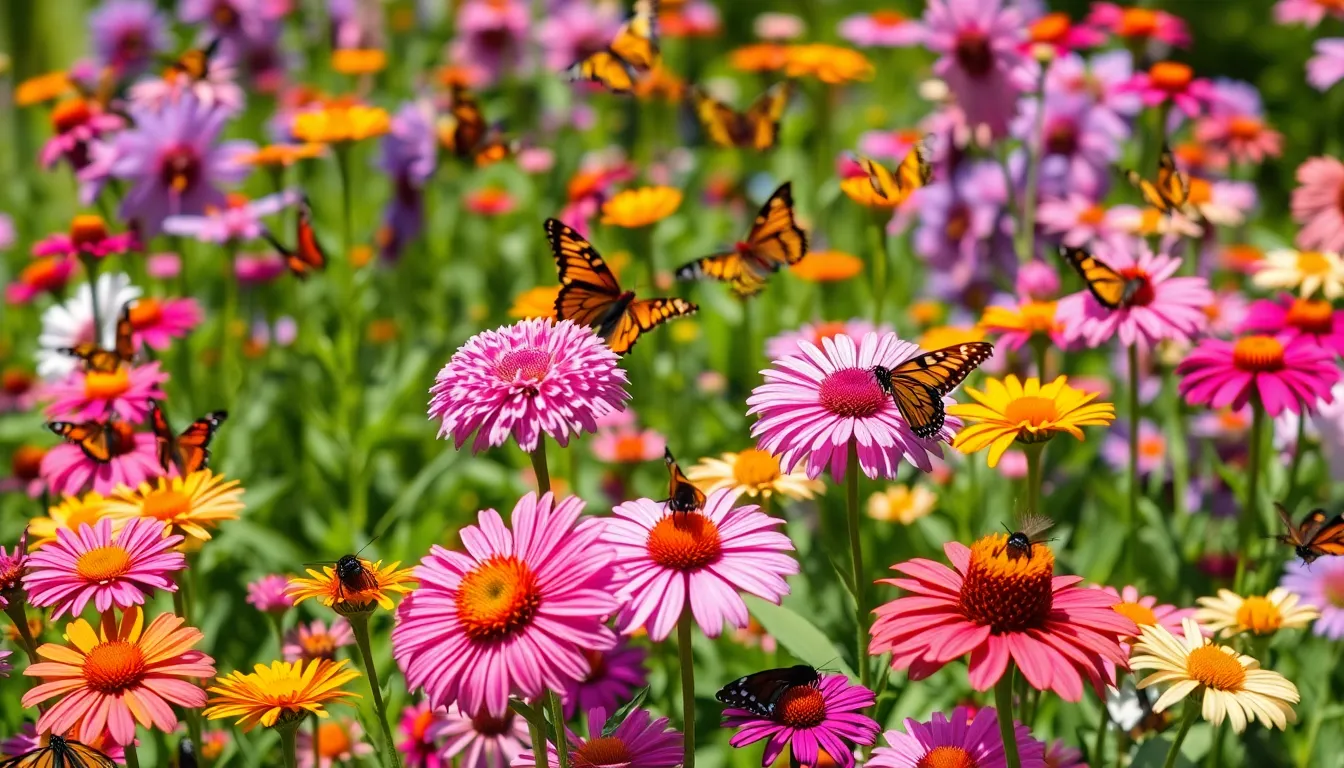
Creating a butterfly garden that maintains visual appeal and supports butterfly populations throughout the growing season requires strategic plant selection timed to natural butterfly lifecycles. We’ll guide you through essential plants for each season to ensure continuous nectar sources and optimal butterfly habitat.
Plan Spring Emergence Plants
Spring awakening plants provide crucial early nectar sources when butterflies emerge from winter dormancy. Gregg’s Mistflower (Conoclinium greggii) offers purple-blue blooms during spring and summer months, establishing reliable nectar sources for newly active butterflies. Butterfly Milkweed (Asclepias tuberosa) begins its blooming cycle in late spring, providing essential resources for monarch butterflies during their northward migration.
Early season wildflowers create foundation plantings that support emerging butterfly populations. These spring bloomers ensure butterflies find immediate food sources after winter hibernation or southern migration. Plant these species in clusters of 3 to 5 specimens to maximize visual impact and butterfly accessibility.
Timing spring plantings coincides with natural butterfly emergence patterns. Most butterfly species become active when temperatures consistently reach 65°F, making early blooming plants essential for garden success. Spring emergence plants also establish root systems before summer heat stress occurs.
Ensure Summer Peak Blooming
Summer flowering plants sustain butterflies during their most active reproductive period. Texas Lantana (Lantana urticoides) produces bright red, orange, and yellow flowers while demonstrating excellent drought tolerance throughout hot summer months. Butterfly Bush remains a popular choice for consistent summer blooming and reliable butterfly attraction.
Peak season bloomers support multiple butterfly generations during summer breeding cycles. These robust plants withstand heat stress while producing abundant nectar when butterfly populations reach maximum numbers. Summer bloomers typically require 6 to 8 hours of direct sunlight daily for optimal flower production.
Continuous summer blooming ensures steady nectar availability during critical reproduction periods. Group similar flowering plants together to create concentrated feeding areas that butterflies can easily locate. Maintain consistent watering schedules for summer bloomers to prevent stress-induced bloom reduction.
Provide Fall Migration Support
Fall flowering plants fuel butterflies preparing for southern migration or winter preparation. Blue Mistflower and White Mistflower attract butterflies during autumn months when nectar sources become increasingly scarce. Coral Honeysuckle (Lonicera sempervirens) supports both hummingbirds and butterflies throughout fall migration periods.
Late season plants provide essential energy reserves for overwintering butterflies. These autumn bloomers help butterflies build fat reserves necessary for winter survival or long-distance migration journeys. Fall migration plants often extend blooming periods into early winter in warmer climates.
Migration support plants create vital stopover habitats during butterfly travel seasons. Position fall bloomers in sheltered locations protected from harsh autumn winds. These strategic plantings serve migrating monarchs and other species requiring high-energy nectar sources before winter dormancy.
Create Maintenance-Free Butterfly Garden Zones
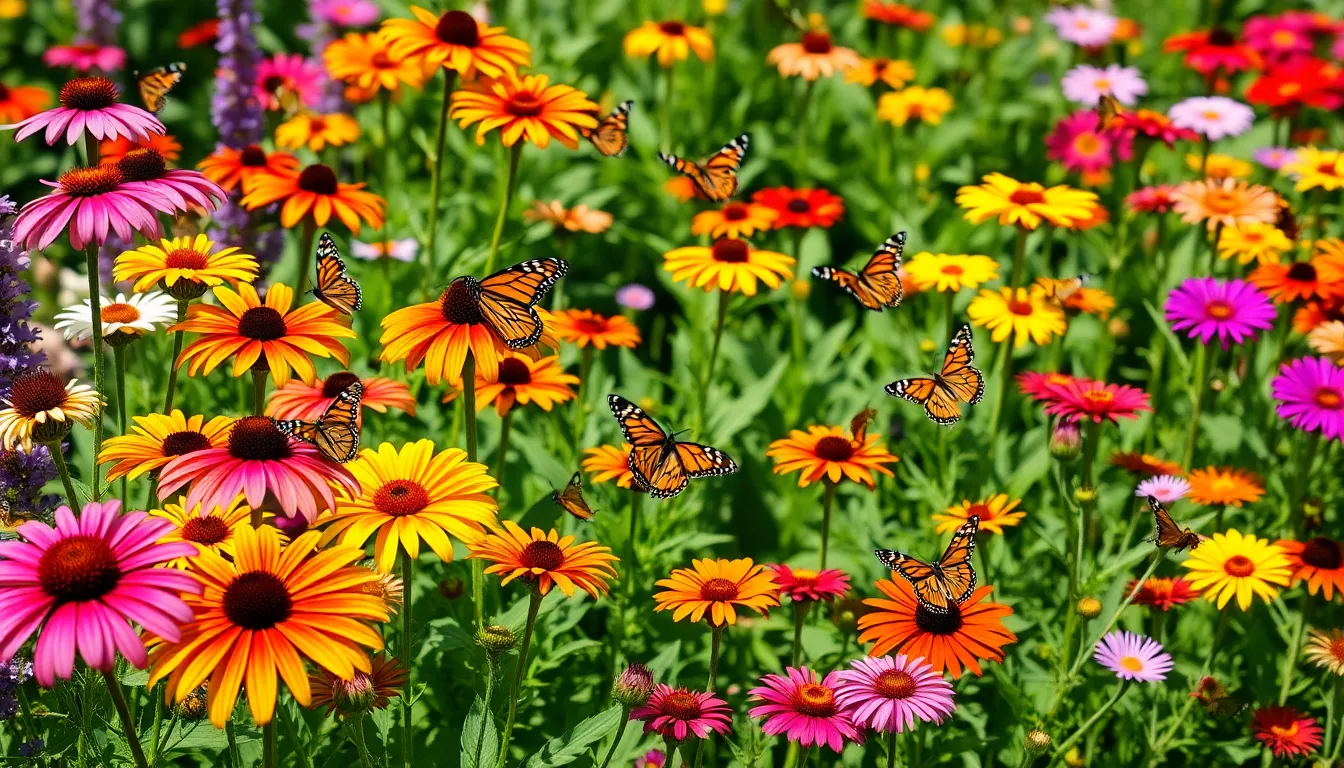
We’ll help you establish butterfly zones that practically maintain themselves with minimal effort. Strategic planning and smart plant choices make your garden thrive while reducing weekly upkeep to nearly zero.
Choose Low Maintenance Perennial Options
Perennial nectar plants form the backbone of our maintenance free butterfly zones because they return year after year without replanting. Coneflowers bloom from July through October and attract over 15 butterfly species including monarchs, swallowtails, and painted ladies. Black eyed Susans provide nectar for 6 to 8 months annually while requiring only occasional deadheading to extend their flowering period.
Butterfly bush varieties offer continuous blooms from summer through fall with minimal care requirements. Purple and white cultivars attract the most butterflies per square foot according to pollinator research. These perennials need only annual pruning and occasional watering during drought periods.
Host plant perennials like milkweed species support butterfly reproduction while eliminating yearly replanting tasks. Common milkweed spreads naturally through underground rhizomes, creating larger colonies that support multiple monarch generations. Swamp milkweed thrives in moist areas and requires zero fertilization while providing essential breeding habitat.
Design Self Seeding Annual Areas
Zinnia varieties drop seeds naturally each fall and germinate the following spring without human intervention. These self seeding annuals create dense flower clusters that attract painted ladies, skippers, and sulfur butterflies throughout the growing season. We recommend planting zinnias in 3 foot by 3 foot patches to maximize their natural reseeding potential.
Marigold sections establish permanent annual zones through their prolific seed production and easy germination rates. French marigolds and African marigolds both self seed reliably in zones 3 through 10, providing nectar sources from early summer until the first frost. These annuals require no soil preparation beyond basic weed removal before their natural emergence.
Cosmos areas develop into self sustaining annual zones that expand naturally each year. Orange cosmos and pink cosmos varieties attract small butterflies like blues and hairstreaks while requiring absolutely no maintenance once established. Their feathery foliage creates natural mulch that suppresses weeds and retains soil moisture.
Carry out Mulching Strategies
Organic mulch layers reduce garden maintenance by 80% while supporting butterfly habitat requirements. Wood chips maintain soil moisture for 4 to 6 weeks longer than unmulched areas, reducing our watering frequency significantly. Straw mulch creates overwintering spaces for beneficial insects while decomposing into soil improving organic matter.
Strategic mulch placement around perennial clusters prevents weed competition without affecting butterfly access to flowers. We apply 2 to 3 inch mulch layers around plant bases while leaving 6 inch clear circles directly around stems. This technique eliminates most hand weeding while allowing butterflies to reach nectar sources easily.
Natural mulch materials like shredded leaves and grass clippings provide free maintenance reduction options. Leaf mulch creates habitat for overwintering butterfly chrysalises while suppressing annual weeds that compete with our butterfly plants. Grass clipping mulch decomposes quickly and enriches soil without additional fertilizer applications.
Conclusion
Creating your butterfly garden becomes an achievable goal when you combine thoughtful planning with the right plant selections. We’ve shown you how native flowers, strategic layouts, and proper water sources work together to support butterfly lifecycles naturally.
Your garden doesn’t need to be perfect from day one. Start small with a few key plants like milkweed and coneflowers, then expand as you gain confidence. The self-seeding varieties and low-maintenance perennials we’ve discussed will help your space flourish with minimal effort.
Remember that every butterfly garden contributes to local conservation efforts while bringing daily joy to your outdoor space. You’re not just growing flowers – you’re creating a vital habitat that supports these magnificent pollinators for generations to come.
Frequently Asked Questions
What makes a successful butterfly garden different from a regular flower garden?
A successful butterfly garden supports butterflies throughout their entire lifecycle, not just adult feeding. It requires both nectar-rich flowers for adult butterflies and specific host plants where they can lay eggs and caterpillars can develop. The garden should also include water sources, shelter areas, and be strategically positioned in sunny locations with minimal pesticide use.
Which native plants are best for attracting butterflies in different regions?
Regional native plants work best: East Coast benefits from New England asters and goldenrod; Midwest thrives with prairie blazingstar and wild lupine; West Coast loves California poppies; and Southern regions should include butterfly weed. Milkweed is essential nationwide as the exclusive host plant for monarch butterflies.
How much space do I need to create an effective butterfly garden?
An ideal butterfly garden requires approximately 100 square feet to accommodate plant diversity, though smaller spaces like balconies can work. The key is ensuring 6-8 hours of direct sunlight daily and creating clustered plantings rather than scattered individual plants to maximize butterfly attraction and activity.
What colors attract the most butterflies to a garden?
Butterflies are attracted to various colors: red and orange flowers like zinnias attract painted ladies; purple blooms such as lavender and salvia are consistent favorites; yellow marigolds and sunflowers provide abundant nectar. Plant multiple colors in clusters to attract diverse butterfly species throughout the growing season.
How do I provide water for butterflies in my garden?
Create shallow puddling stations using small containers filled with sand or pebbles, providing mineral-rich water sources. Install butterfly baths with perching surfaces and maintain moist soil areas. Butterflies need shallow water for drinking and extracting vital minerals essential for their health and reproduction.
Should I use pesticides in my butterfly garden?
Avoid chemical pesticides and herbicides as they harm butterflies and caterpillars. Instead, use natural alternatives like neem oil and pyrethrin for pest control. Encourage beneficial insects like ladybugs and lacewings, and practice companion planting with basil and marigolds to naturally deter pests while supporting butterflies.
How can I maintain continuous blooms throughout the growing season?
Select plants with staggered blooming periods: spring emergence plants like butterfly milkweed, summer peak bloomers such as lantana and butterfly bush, and fall migration support flowers including blue mistflower. This succession ensures consistent nectar sources for multiple butterfly generations throughout the year.
What are the most low-maintenance plants for butterfly gardens?
Choose perennial options like coneflowers, black-eyed Susans, and purple coneflowers that return annually with minimal care. Self-seeding annuals such as zinnias and marigolds establish permanent zones with little effort. Use organic mulch like wood chips to retain moisture, suppress weeds, and reduce overall maintenance requirements.
